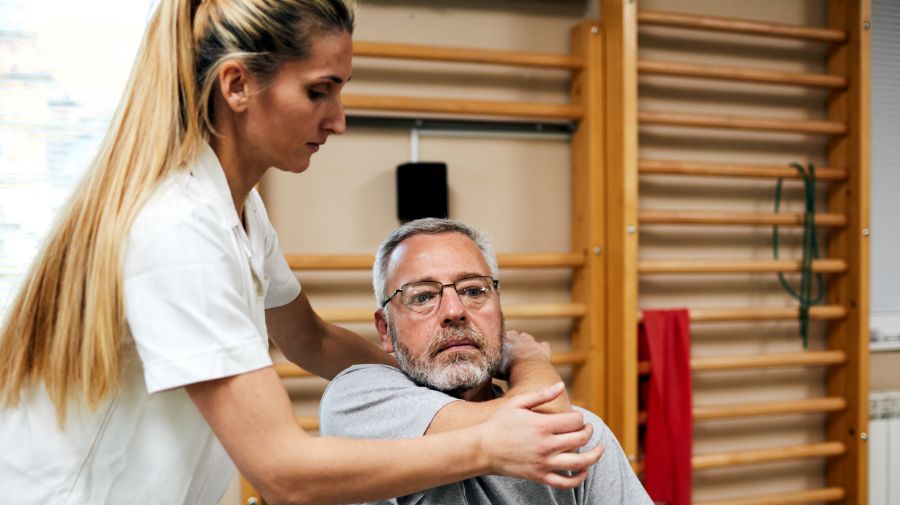How to document a non-cooperative session

As a physical, occupational, or speech therapist, your primary goal is to help people. Unfortunately, sometimes, people don’t want to be helped. Whether they fail to realize the therapeutic value of the work you’re asking them do, thinking the work is too frustrating or just woke up on the wrong side of the bed, there are days where you may encounter clients who refuse to cooperate, and might even be rude. It’s incredibly frustrating, and then while trying to figure out how to approach this issue, you remember you still have to document it. So, how do you do it?
Why do I have to document these sessions?
It might seem difficult to professionally document when your client flat out refuses to do an exercise (especially if they’re rude about it). Yet documenting these instances is crucial for several reasons, such as maintaining an accurate record of treatment progress, ensuring continuity of care, and facilitating communication with other healthcare professionals. Whether a session gets shortened, pushed to another day or you refer the client to another professional, you need to document all this.
How to document non-cooperative client sessions
Maintain detailed descriptions
When documenting non-cooperative client sessions, it is important to provide a comprehensive description of the client’s behavior. Be specific about the exercises they refused to perform, the reasons given for non-compliance, and any attempts made to encourage their participation. Including objective observations, such as body language, facial expressions, and verbal responses, can provide valuable context. Don’t forget to maintain objectivity and be tactful when documenting. Another family member, caregiver or medical professional could read it to figure out where to go from there.
Example:
“During today’s session, the client exhibited signs of non-cooperation by verbally refusing to engage in the prescribed range of motion exercises for the left shoulder. Despite providing detailed instructions and encouragement, they expressed discomfort and unwillingness to continue.”
Include client’s perspective
To ensure a holistic account of the session, therapists should include the client’s perspective. This can help identify potential barriers to engagement or understand any concerns they may have. Document any conversations that delve into the reasons behind their refusal, their anxieties, or any other factors affecting their motivation. It may be necessary to educate your client on the benefits – and limitations – of your services, and the difference between progress and issues. Sometimes, the missing ingredient is communication.
Example:
“The therapist took the time to have a conversation with the client, addressing their concerns regarding pain and discomfort during the exercise. It was identified that the technique might need adjustment to accommodate their individual needs and reduce anxiety.”
Note modifications and adaptations
In cases where clients refuse to cooperate with specific exercises, it becomes essential to document any modifications or adaptations made. These modifications should focus on enabling clients to continue with an alternative exercise or adjustment that caters to their capabilities. Highlighting the efforts made to tailor the session to the client’s needs showcases the therapist’s dedication to maintaining progress.
Example:
“Given the client’s unwillingness to perform the recommended squats due to knee discomfort, the therapist introduced a seated leg press machine as an alternative exercise. Through this modification, the client was able to engage in a comparable lower-body strengthening exercise while minimizing discomfort.”
Document strategies implemented
Therapists should also document the strategies employed to encourage client cooperation during the session. This may include motivational techniques, positive reinforcement, or employing visual aids to enhance understanding. By recording these strategies, therapists can identify successful techniques and replicate them in subsequent sessions.
Example:
“To address the client’s refusal to practice speech exercises, the therapist introduced a game-based approach, incorporating interactive flashcards and verbal cues. This strategy engaged the client and improved their overall response and participation.”
Use Ensora Rehab Therapy Suite to document more easily
Documenting non-cooperative sessions can be challenging, but with the right tools, it can become significantly easier. Ensora Rehab Therapy Suite is designed to help physical, occupational, and speech therapists streamline their documentation process, allowing them to focus more on client care. Here are some features that make Ensora Rehab Therapy Suite a valuable tool for your practice:
Customizable templates for consistent documentation
Ensora Rehab Therapy Suite allows you to create custom templates tailored to your specific documentation needs. Whether you’re documenting a non-cooperative session, a progress report, or a routine check-in, templates can help ensure that you’re capturing all the necessary information in a structured and efficient manner. For example, create a template specifically for non-cooperative sessions that prompts you to include client behaviors, reasons for refusal, modifications made, and follow-up strategies. This feature helps you maintain consistency across sessions, ensuring that important details like client feedback, modifications, and strategies are always documented.
Pre-written phrases to save time
Ensora Rehab Therapy Suite comes with a library of pre-written phrases that you can customize to document common scenarios more quickly. For example, if you frequently encounter clients refusing exercises or needing modifications, you can select from a library of professionally written phrases that accurately describe these situations. This feature can be especially helpful for documenting behaviors or responses that happen regularly, such as resistance to certain exercises or a need for alternative strategies. Customize and save your own frequently-used phrases for even faster documentation. This is particularly helpful if you work with clients who have similar needs or challenges, allowing you to maintain consistency in your notes.
Other helpful tools
Photo and Video Attachments: If applicable, you can attach photos or videos of a client’s performance (with their consent) to provide a more comprehensive view of their progress or challenges.
Reminders for Follow-Ups: Ensora Rehab Therapy Suite can set reminders to check in on specific clients or readdress certain issues in future sessions, ensuring no detail is overlooked.
Documenting non-cooperative client sessions is essential for maintaining accurate treatment records and ensuring overall continuity of care. Physical, occupational, and speech therapists can effectively capture these sessions by providing detailed descriptions, including the client’s perspective, noting modifications, and documenting the strategies implemented. This not only aids in tracking progress but also facilitates communication with other healthcare professionals, enabling a collaborative approach towards achieving optimal client outcomes.
Ensora Rehab Therapy Suite can help you document smarter, not harder
Ensora Rehab Therapy Suite can’t make your clients do their HEPs, but we can help you create comprehensive documentation faster and more easily so you can focus on client care. Let us show you what else Ensora Rehab Therapy Suite can do in a demo.






